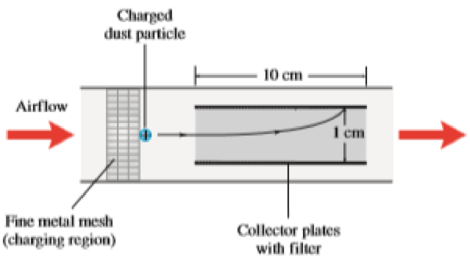
An air ionizer fillers particles of dust, pollen, and other allergens from the air using electric forces. In one type of ionizer (see diagram), a stream of air is drawn in with a speed of 3.0 m/s. The air passes through a fine, highly charged wire mesh that transfers electric charge to the particles. Then the air passes through parallel “collector” plates that admet the charged particles and trap them in a filter. Consider a dust particle of radius 6.0 μm, mass 2.0 × 10–13 kg, and charge l000e. The plates are 10 cm long and are separated by a distance of 10 cm. (a) Ignoring drag forces, what would be the minimum potential difference between the plates to ensure that the particle gets trapped by the filter? (b) At what speed would the particle be moving relative to the stream of air just before hitting the filter? (c) Calculate the viscous drag force on the particle when moving at the speed found in (b). (d) Is it realistic to ignore drag? Taking drag into consideration, is the minimum potential difference larger or smaller than the answer to (a)?

(a)
The minimum potential difference between the plates to ensure that the particle gets trapped by the filter.
Answer to Problem 125P
The minimum potential difference between the plates to ensure that the particle gets trapped by the filter is
Explanation of Solution
Write the equation for the time taken by the dust particle to pass through the length of the collector plates.
Here,
Write the equation of motion in vertical direction.
Here,
The initial speed of the particle in the vertical direction is zero.
Substitute
Put equation (I) in equation (II).
Write the equation for the net force on the particle in the vertical direction.
Here,
Rewrite the above equation for
The net force in the vertical direction is equal to the electric force.
Write the relationship between the net force and the electric force.
Here,
Put the above equation in equation (IV).
Write the equation for the electric force.
Here,
Write the equation for the electric field.
Here,
Put the above equation in equation (VI).
Put equation (VII) in equation (V).
Equate equations (III) and (VIII) and rewrite it for
Substitute
Here,
Conclusion:
The value of
Substitute
Therefore, the minimum potential difference between the plates to ensure that the particle gets trapped by the filter is
(b)
The speed at which the particle would be moving relative to the stream of air just before hitting the filter.
Answer to Problem 125P
The speed at which the particle would be moving relative to the stream of air just before hitting the filter is
Explanation of Solution
Write the equation of motion in vertical direction.
Here,
Substitute
Put equation (II) in the above equation.
Put equation (I) in the above equation.
Conclusion:
Substitute
Therefore, the speed at which the particle would be moving relative to the stream of air just before hitting the filter is
(c)
The viscous drag force on the particle when moving at the speed found in part (b).
Answer to Problem 125P
The viscous drag force on the particle when moving at the speed found in part (b) is
Explanation of Solution
Write the equation for the drag force.
Here,
Conclusion:
The viscosity of air is
Substitute
Therefore, the viscous drag force on the particle when moving at the speed found in part (b) is
(d)
Whether it is realistic to ignore the drag and whether the minimum potential difference larger or smaller than the answer to part (a) when drag is considered.
Answer to Problem 125P
It is not realistic to ignore the drag and the minimum potential difference should be larger when drag is considered.
Explanation of Solution
It is realistic to ignore the drag if the drag force is much smaller than the electric force.
Substitute
Conclusion:
Substitute
The value of
Therefore, it is not realistic to ignore the drag and the minimum potential difference should be larger when drag is considered.
Want to see more full solutions like this?
Chapter 17 Solutions
Physics
- Two complex values are z1=8 + 8i, z2=15 + 7 i. z1∗ and z2∗ are the complex conjugate values. Any complex value can be expessed in the form of a+bi=reiθ. Find r and θ for (z1-z∗2)/z1+z2∗. Find r and θ for (z1−z2∗)z1z2∗ Please show all stepsarrow_forwardAn electromagnetic wave is traveling through vacuum in the positive x direction. Its electric field vector is given by E=E0sin(kx−ωt)j^,where j^ is the unit vector in the y direction. If B0 is the amplitude of the magnetic field vector, find the complete expression for the magnetic field vector B→ of the wave. What is the Poynting vector S(x,t), that is, the power per unit area associated with the electromagnetic wave described in the problem introduction? Give your answer in terms of some or all of the variables E0, B0, k, x, ω, t, and μ0. Specify the direction of the Poynting vector using the unit vectors i^, j^, and k^ as appropriate. Please explain all stepsarrow_forwardAnother worker is performing a task with an RWL of only 9 kg and is lifting 18 kg, giving him an LI of 2.0 (high risk). Questions:What is the primary issue according to NIOSH?Name two factors of the RWL that could be improved to reduce risk.If the horizontal distance is reduced from 50 cm to 30 cm, how does the HM change and what effect would it have?arrow_forward
- Two complex values are z1=8 + 8i, z2=15 + 7 i. z1∗ and z2∗ are the complex conjugate values. Any complex value can be expessed in the form of a+bi=reiθ. Find r and θ for z1z2∗. Find r and θ for z1/z2∗? Find r and θ for (z1−z2)∗/z1+z2∗. Find r and θ for (z1−z2)∗/z1z2∗ Please explain all steps, Thank youarrow_forwardAn ac series circuit consists of a voltage source of frequency 60 Hz and voltage amplitude V, a 505-Ω resistor, and a capacitor of capacitance 7.2 μF. What must be the source voltage amplitude V for the average electrical power consumed in the resistor to be 236 W? There is no inductance in the circuit.arrow_forwardAn L−R−C series circuit has R= 280 Ω . At the frequency of the source, the inductor has reactance XLL= 905 Ω and the capacitor has reactance XC= 485 Ω . The amplitude of the voltage across the inductor is 445 V . What is the amplitude of the voltage across the resistor and the capacitor? What is the voltage amplitude of the source? What is the rate at which the source is delivering electrical energy to the circuit?arrow_forward
- A 0.185 H inductor is connected in series with a 98.5 Ω resistor and an ac source. The voltage across the inductor is vL=−(12.5V)sin[(476rad/s)t]vL. Derive an expression for the voltage vR across the resistor. Express your answer in terms of the variables L, R, VL (amplitude of the voltage across the inductor), ω, and t. What is vR at 2.13 ms ? Please explain all stepsarrow_forwardA worker lifts a box under the following conditions:Horizontal distance (H): 30 cmInitial height (V): 60 cmVertical travel (D): 50 cmTorso rotation (A): 30°Frequency: 3 times/minute for 1 hourGrip: Good Question:What is the RWL for this task?What does this value mean in terms of occupational safety?arrow_forwardCan someone helparrow_forward
- Can someone help mearrow_forward3. Four identical small masses are connected in a flat perfect square. Rank the relative rotational inertias (IA, IB, IC) about the three axes of rotation shown. Axes A and B are in the plane of the square, and axis C is perpendicular to the plane, through mass m1. ΙΑ IB m2 m1 m3 Ic m4 (a) IAarrow_forwardConsider the circuit shown in the figure below. (Assume L = 5.20 m and R2 = 440 Ω.) (a) When the switch is in position a, for what value of R1 will the circuit have a time constant of 15.4 µs? (b) What is the current in the inductor at the instant the switch is thrown to position b?arrow_forwardarrow_back_iosSEE MORE QUESTIONSarrow_forward_ios
 Principles of Physics: A Calculus-Based TextPhysicsISBN:9781133104261Author:Raymond A. Serway, John W. JewettPublisher:Cengage Learning
Principles of Physics: A Calculus-Based TextPhysicsISBN:9781133104261Author:Raymond A. Serway, John W. JewettPublisher:Cengage Learning Physics for Scientists and EngineersPhysicsISBN:9781337553278Author:Raymond A. Serway, John W. JewettPublisher:Cengage Learning
Physics for Scientists and EngineersPhysicsISBN:9781337553278Author:Raymond A. Serway, John W. JewettPublisher:Cengage Learning Physics for Scientists and Engineers with Modern ...PhysicsISBN:9781337553292Author:Raymond A. Serway, John W. JewettPublisher:Cengage Learning
Physics for Scientists and Engineers with Modern ...PhysicsISBN:9781337553292Author:Raymond A. Serway, John W. JewettPublisher:Cengage Learning College PhysicsPhysicsISBN:9781938168000Author:Paul Peter Urone, Roger HinrichsPublisher:OpenStax College
College PhysicsPhysicsISBN:9781938168000Author:Paul Peter Urone, Roger HinrichsPublisher:OpenStax College Physics for Scientists and Engineers: Foundations...PhysicsISBN:9781133939146Author:Katz, Debora M.Publisher:Cengage Learning
Physics for Scientists and Engineers: Foundations...PhysicsISBN:9781133939146Author:Katz, Debora M.Publisher:Cengage Learning College PhysicsPhysicsISBN:9781305952300Author:Raymond A. Serway, Chris VuillePublisher:Cengage Learning
College PhysicsPhysicsISBN:9781305952300Author:Raymond A. Serway, Chris VuillePublisher:Cengage Learning





